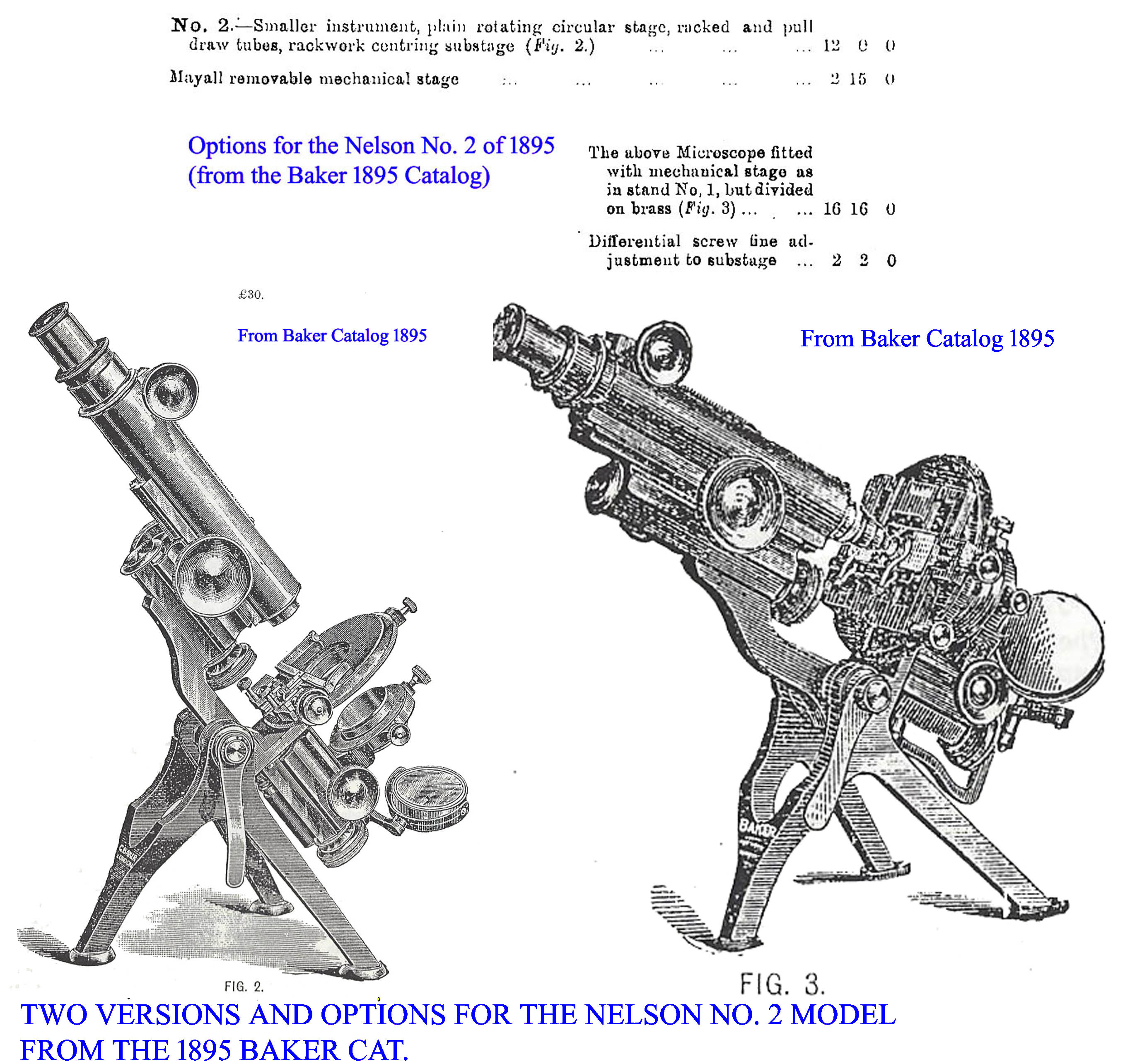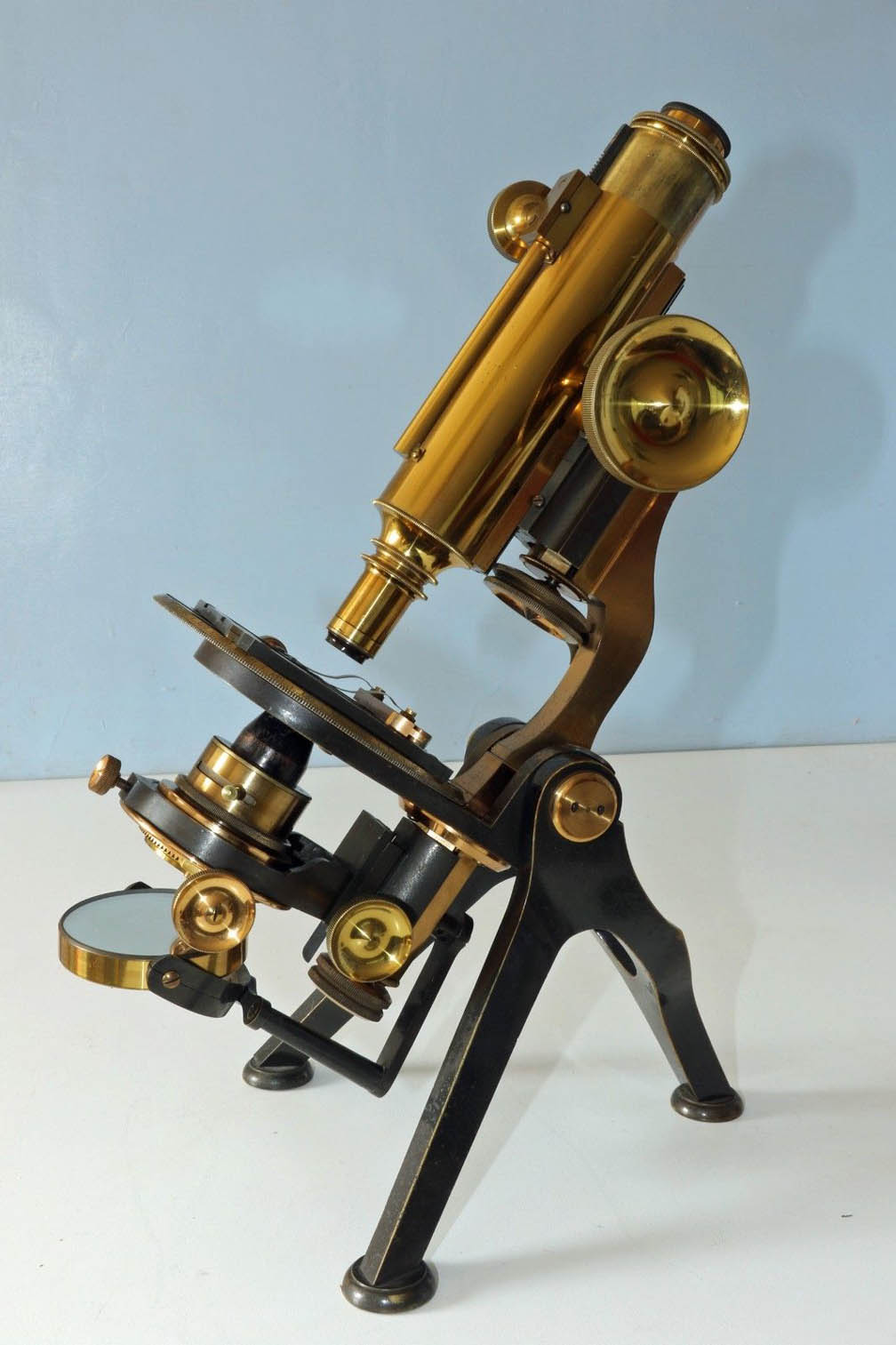HISTORY OF THE NELSON-CURTIES MICROSCOPES
MAKER: CHARLES BAKER COMPANY
THE 'NELSON NO. 2' MICROSCOPES OF 1895

 In 1895 two different examples of the Nelson No. 2 were offered. The basic model, seen to the left of the engraving, cost £12. This basic model had a dual controlled type mechanical stage, (confusingly pictured on the more expensive stand to the right in the engraving), and a rack and pinion driven rotating and centering substage. For an extra £2 15, the 'Mayall removable mechanical stage' was substituted. The Mayall stage is actually pictured on the engraving, to the left, even though it was not standard for that model. For £16 16, the dual control mechanical stage as on the number 2 was supplied with the addition of engraved divisions. This was not a Mayall type stage however. For both number 2's the fine adjustment to the substage continued to be optional, and cost an extra £2 2. That would bring the total cost of the No 2 with all the options up to £18 18. An actual example of the more expensive No 2 with the additional and optional features of graduated silvered rotation to the (not Mayall)stage, and fine adjustment to the substage, complete with the rack and pinion driven substage rotation is shown to the left. This model also has its scales for slide location engraved on oxidized brass rather than nickel as in the later number two on this site. Its round toes of the tripod foot not being slotted, support the notion that this is a relatively early Model, certainly before 1896 when the front two toes of the stand became routinely slotted. Its features strongly resemble the original stand of 1889 as pictured in the JRMS, but with the addition of geared rotation to the substage, the calibrated stage rotation, and the stouter two control mechanical stage. Instead of two bars to hold the slide, this stage has two stage clips protruding from a single bottom bar, just like the stand in the right side of the engraving. It almost certainly dates to about 1895. Rotation for the substage by rack and pinion was discontinued for the number two starting in 1898.
In 1895 two different examples of the Nelson No. 2 were offered. The basic model, seen to the left of the engraving, cost £12. This basic model had a dual controlled type mechanical stage, (confusingly pictured on the more expensive stand to the right in the engraving), and a rack and pinion driven rotating and centering substage. For an extra £2 15, the 'Mayall removable mechanical stage' was substituted. The Mayall stage is actually pictured on the engraving, to the left, even though it was not standard for that model. For £16 16, the dual control mechanical stage as on the number 2 was supplied with the addition of engraved divisions. This was not a Mayall type stage however. For both number 2's the fine adjustment to the substage continued to be optional, and cost an extra £2 2. That would bring the total cost of the No 2 with all the options up to £18 18. An actual example of the more expensive No 2 with the additional and optional features of graduated silvered rotation to the (not Mayall)stage, and fine adjustment to the substage, complete with the rack and pinion driven substage rotation is shown to the left. This model also has its scales for slide location engraved on oxidized brass rather than nickel as in the later number two on this site. Its round toes of the tripod foot not being slotted, support the notion that this is a relatively early Model, certainly before 1896 when the front two toes of the stand became routinely slotted. Its features strongly resemble the original stand of 1889 as pictured in the JRMS, but with the addition of geared rotation to the substage, the calibrated stage rotation, and the stouter two control mechanical stage. Instead of two bars to hold the slide, this stage has two stage clips protruding from a single bottom bar, just like the stand in the right side of the engraving. It almost certainly dates to about 1895. Rotation for the substage by rack and pinion was discontinued for the number two starting in 1898.

 In 1895 two different examples of the Nelson No. 2 were offered. The basic model, seen to the left of the engraving, cost £12. This basic model had a dual controlled type mechanical stage, (confusingly pictured on the more expensive stand to the right in the engraving), and a rack and pinion driven rotating and centering substage. For an extra £2 15, the 'Mayall removable mechanical stage' was substituted. The Mayall stage is actually pictured on the engraving, to the left, even though it was not standard for that model. For £16 16, the dual control mechanical stage as on the number 2 was supplied with the addition of engraved divisions. This was not a Mayall type stage however. For both number 2's the fine adjustment to the substage continued to be optional, and cost an extra £2 2. That would bring the total cost of the No 2 with all the options up to £18 18. An actual example of the more expensive No 2 with the additional and optional features of graduated silvered rotation to the (not Mayall)stage, and fine adjustment to the substage, complete with the rack and pinion driven substage rotation is shown to the left. This model also has its scales for slide location engraved on oxidized brass rather than nickel as in the later number two on this site. Its round toes of the tripod foot not being slotted, support the notion that this is a relatively early Model, certainly before 1896 when the front two toes of the stand became routinely slotted. Its features strongly resemble the original stand of 1889 as pictured in the JRMS, but with the addition of geared rotation to the substage, the calibrated stage rotation, and the stouter two control mechanical stage. Instead of two bars to hold the slide, this stage has two stage clips protruding from a single bottom bar, just like the stand in the right side of the engraving. It almost certainly dates to about 1895. Rotation for the substage by rack and pinion was discontinued for the number two starting in 1898.
In 1895 two different examples of the Nelson No. 2 were offered. The basic model, seen to the left of the engraving, cost £12. This basic model had a dual controlled type mechanical stage, (confusingly pictured on the more expensive stand to the right in the engraving), and a rack and pinion driven rotating and centering substage. For an extra £2 15, the 'Mayall removable mechanical stage' was substituted. The Mayall stage is actually pictured on the engraving, to the left, even though it was not standard for that model. For £16 16, the dual control mechanical stage as on the number 2 was supplied with the addition of engraved divisions. This was not a Mayall type stage however. For both number 2's the fine adjustment to the substage continued to be optional, and cost an extra £2 2. That would bring the total cost of the No 2 with all the options up to £18 18. An actual example of the more expensive No 2 with the additional and optional features of graduated silvered rotation to the (not Mayall)stage, and fine adjustment to the substage, complete with the rack and pinion driven substage rotation is shown to the left. This model also has its scales for slide location engraved on oxidized brass rather than nickel as in the later number two on this site. Its round toes of the tripod foot not being slotted, support the notion that this is a relatively early Model, certainly before 1896 when the front two toes of the stand became routinely slotted. Its features strongly resemble the original stand of 1889 as pictured in the JRMS, but with the addition of geared rotation to the substage, the calibrated stage rotation, and the stouter two control mechanical stage. Instead of two bars to hold the slide, this stage has two stage clips protruding from a single bottom bar, just like the stand in the right side of the engraving. It almost certainly dates to about 1895. Rotation for the substage by rack and pinion was discontinued for the number two starting in 1898.